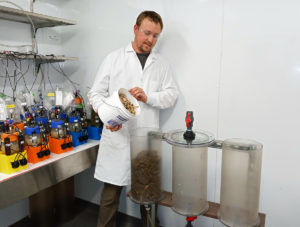
Colorado State University researchers are part of a team developing a first-of-its-kind system that will create renewable energy while diverting waste from landfills. The project will combine technologies pioneered at CSU and the National Renewable Energy Laboratory.
The collaboration was awarded $3.5 million from the U.S. Department of Energy, and the project is one of 68 selected to receive a total of $175 million to develop novel clean energy technologies. CSU will receive $1.3 million of the award to build on anaerobic digestion research in the Department of Civil and Environmental Engineering.
The project – dubbed ReSOURCE, or Recirculating System for Optimal Use of Refuse with Control and Efficiency – aims to produce the first carbon-negative biorefinery. ReSOURCE will convert organic waste into valuable products, such as sustainable aviation fuel, cleaning solvents and lubricants.
“It’s taking waste material with high carbon content and converting that carbon into something that replaces the carbon in fossil fuels,” said Sybil Sharvelle, principal investigator for CSU’s share of the project and a professor in civil and environmental engineering.
Decomposition, interrupted

Decomposing organic matter, including food, manure and yard waste, releases methane and other gases as it is digested by microbes. ReSOURCE will interrupt this natural process, called anaerobic digestion, stopping it short of methane production.
Arrested anaerobic digestion yields intermediate chemicals, including volatile fatty acids, which can be used to make valuable, sustainable products and fuels. NREL has developed an advanced separation process that can effectively isolate volatile fatty acids from the waste stream.
“We’re engineering this natural process to capture high-value products,” said Susan De Long, co-investigator and associate professor in civil and environmental engineering.
Similar projects have failed due to a major complication: microbial communities used in controlled anaerobic digestion are sensitive to variation in their food. When the waste composition changes, the system often crashes.
To solve this problem, Sharvelle and De Long have collaborated for years on an anaerobic digestion system co-invented by Sharvelle and Ph.D. student Lucas Loetscher. Loetscher also co-founded Nexus Bioenergy, a partner on the DOE project.
The modular design of Sharvelle and Loetscher’s system combined with De Long’s insights into microbial tailoring – cultivating the right microbes for the job – will enable ReSOURCE to handle a broad range of waste without crashing the system.
Path to profitability
Integrating NREL’s separation technology with CSU’s advances in anaerobic digestion and microbial management positions ReSOURCE to overcome challenges that have prevented the commercial viability of converting organic waste into products through anaerobic digestion.
“Landfills are still the most cost-effective way to dispose of many organic wastes,” Loetscher said. “The ReSOURCE process aims to change this by converting these low-grade wastes into valuable organic molecules.”
Left to landfills, organic matter releases methane and carbon dioxide – greenhouse gases – as microbes break it down. Once the ReSOURCE technology is fully developed, it will provide financial incentive for diverting waste.
Eric Karp, principal investigator for the project and a chemical engineer at NREL, estimates the biochemicals and biofuels produced by ReSOURCE could offset the carbon dioxide equivalent of 6.2 million cars a year.
“Organic wastes are untapped resources for energy production,” De Long said. “These kinds of projects have the potential for significant impacts on mitigating climate change. That’s why I get up every day and do this kind of work.”
ReSOURCE, led by NREL, involves industry partners Nexus Bioenergy, Zaiput and Alder Energy. The project was funded through the Advanced Research Projects Agency-Energy (ARPA-E) OPEN 2021 program, which prioritizes high-impact, high risk technologies that support novel approaches to clean energy challenges.